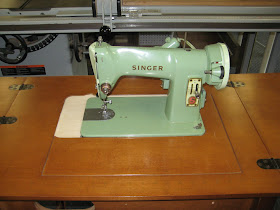Family Heir-Loom Weavers operate over 40 power looms with Jacquard attachments. The Jacquard is an accessory to the hand and power loom. It was intended to supersede the draw loom. It is used to control and independently operate a single or large number of warp threads. With the ability to manipulate an individual thread allowed for the creation of fancy coverlets. Instead of coverlets with geometric shapes you could have animals, buildings, etc.
The Jacquard coverlet on the rack dated 1838 is what got David Kline started in the business. Family Heir-Looms sells a reproduction of this coverlet (seen on the left side of the rack).
 Here David is holding a sample carpet they reproduced for the U.S. Park Service from an original for Lincoln's home in Springfield. You can see the carpet here (top photo). The Klines have done 3 rooms in Lincoln's home and have since done work in 8 other Presidential homes including Mount Vernon.
Here David is holding a sample carpet they reproduced for the U.S. Park Service from an original for Lincoln's home in Springfield. You can see the carpet here (top photo). The Klines have done 3 rooms in Lincoln's home and have since done work in 8 other Presidential homes including Mount Vernon. When recreating any pattern David said the first step in the Jacquard process is to create the point paper (a carefully graphed and hand-painted design). The point paper is an accurate map of the finished project.
When recreating any pattern David said the first step in the Jacquard process is to create the point paper (a carefully graphed and hand-painted design). The point paper is an accurate map of the finished project.  Punched cards are created from the point paper. The punched cards are a mechanized way of lifting warp threads to make a figured design. In the early 1800's Joseph-Marie Jacquard perfected an ingenious system of cards punched with holes which, when attached to a draw loom, would allow some needles to pass through and block others.
Punched cards are created from the point paper. The punched cards are a mechanized way of lifting warp threads to make a figured design. In the early 1800's Joseph-Marie Jacquard perfected an ingenious system of cards punched with holes which, when attached to a draw loom, would allow some needles to pass through and block others.  Family Heir-Looms also weaves jean cloth (gray material used to create the jacket in the picture) used in period movies and by reenactors. The tiled walls are still in place from when the building served as a dairy.
Family Heir-Looms also weaves jean cloth (gray material used to create the jacket in the picture) used in period movies and by reenactors. The tiled walls are still in place from when the building served as a dairy. Next we got to tour the weaving rooms. Here are a series of pictures since I couldn't take a picture that captured the entire loom in one frame. Click any picture to enlarge, click twice to enlarge even more.
Next we got to tour the weaving rooms. Here are a series of pictures since I couldn't take a picture that captured the entire loom in one frame. Click any picture to enlarge, click twice to enlarge even more.Back of the loom. Family Heir-Looms often puts 600 yard warps on.
 Jacquard looms don't have harnesses instead the warp threads travel through "eyelets". The eyelets attached to harness cords that pass through a perforated board then head up toward the ceiling.
Jacquard looms don't have harnesses instead the warp threads travel through "eyelets". The eyelets attached to harness cords that pass through a perforated board then head up toward the ceiling. The Jacquard apparatus determines, based on the number and arrangement of the holes in the cards, which of the individual warp threads will be lifted. For every throw of the shuttle the blank part of the card moves a series of pins or levers which raise certain warp threads while other levers, passing into the holes in the card, do nothing, so it has no affect on the other warp threads. Every pattern requires a separate set of cards.
The Jacquard apparatus determines, based on the number and arrangement of the holes in the cards, which of the individual warp threads will be lifted. For every throw of the shuttle the blank part of the card moves a series of pins or levers which raise certain warp threads while other levers, passing into the holes in the card, do nothing, so it has no affect on the other warp threads. Every pattern requires a separate set of cards. Endless chain of pattern cards.
Endless chain of pattern cards. Front of the loom with the finished cloth rolled onto the cloth beam.
Front of the loom with the finished cloth rolled onto the cloth beam.










































